
MAY CONTAIN NUTS

Search Shorpy
SHORPY ART

Framed or unframed, desk size to sofa size, printed by us in Arizona and Alabama since 2007. Explore now.
Join and Share
Ad-Free Shorpy
Shorpy is funded by you. Patreon contributors get an ad-free experience.
Learn more.

Recent comments
- Button It Up
- And with an eye on the time ...
- Working in an enclosed ashtray
- Rear View Mirror?
- Tobacco cam
- Basic fact I learned only later in life
- Put a Lid on it!
- Pinstripes in the Tower
- Sound enhancement
- 3438 in '38
- Second Career
- Their days are numbered
- Only the Sensor
- Train control mechanism
- Rarest of the Rare?? & Classy 3400 Class
- Control Mechanism
- Those standpipes
- Wrenches
- International D-40 I believe
- Job prospects
- You had me at Train
- Land of the free
- Broad-Exchange Bldg
- Parking innovation
- The old block
- "Peck turned a sweet propeller"
- National Bank Building
- Notch shot
- Straight ahead (right, left, left, right)
- Ship lifespans
Member Photos
The Shorpy
Printporium
Printporium
Search Shorpy
Search results -- 30 results per page
- Weld Noir: 1943
- ... Liberty ship construction. Welding on a hatch assembly at night." Medium format negative by Arthur Siegel for the Office of War ... Posted by Dave - 11/18/2014 - 11:32am -
![Weld Noir: 1943 May 1943. "Bethlehem-Fairfield shipyards, Baltimore, Maryland. Liberty ship construction. Welding on a hatch assembly at night." Medium format negative by Arthur Siegel for the Office of War Information. View full size.
There are more handlebars in this photothan there are bicycles.
[Looking for the house across the street? - Dave]
Nautical TermsA hatch is an opening between decks. A door is an opening in a bulkhead. The welder is working on a door.
[It's a hatch subassembly. There is no ship yet. - Dave]
(The Gallery, Arthur Siegel, Baltimore, Industry & Public Works, WW2)](https://www.shorpy.com/files/images/SHORPY-8d28738a.thumbnail.jpg)
- Glassworks Boy: 1908
- August 1908. "A Glass Works Boy waiting for the Night Shift. Indiana Glass Works." Photograph by Lewis Wickes Hine. View full ... Posted by Dave - 01/01/2013 - 8:38pm -
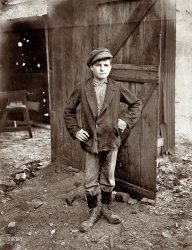
- Call Me Bossy: 1936
- ... farmer on the homestead, would call the cows home at night from pasture for feed 'hey bossy bossy, hey bossy bossy'. And they'd come ... Posted by Dave - 12/08/2012 - 4:30pm -
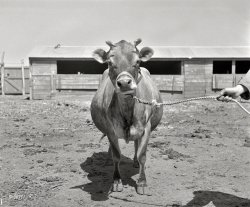
- Rescue Methods: 1917
- ... by name.
I'll mine with my missus
From morning 'til night;
No non-Manning misses
Can bring such delight.
Memories ... Posted by Dave - 08/07/2012 - 11:05am -
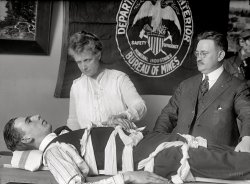
- Dead End: 1905
- ... trunks have a whitewash applied to them. To see better at night?
[Once commonly done in an attempt to control insects or "sun ... Posted by Dave - 05/08/2018 - 7:50am -
![Dead End: 1905 Circa 1905. "Cemetery Avenue, Springfield, Mass." 8x10 inch dry plate glass negative, Detroit Publishing Company. View full size.
A less grand entrance. Or, uh... exit, as the case may be.
There is a building there to the left that mimics the appearance of the now missing portal:
WhitewashedIt appears that all the tree trunks have a whitewash applied to them. To see better at night?
[Once commonly done in an attempt to control insects or "sun scald." -tterrace]
City of the DeadThe historic entry drive.
The Majestic Elmsmust have all been victims of Dutch Elm disease. I'm thinking the whitewash is indeed an attempt to battle the scourge that wiped out the American Elm.
[Dutch elm disease wasn't discovered in Europe until 1910 and not found in North America until 1928. - tterrace]
Lost New EnglandThere's an alternate view here.
(The Gallery, DPC)](https://www.shorpy.com/files/images/SHORPY-4a12236a1.thumbnail.jpg)
- KNX Radio in 1967
- ... with my time machine. Tlachiquero, save me a seat on the night the Byrds are playing. If it's "Sweetheart of the Rodeo"-era Byrds, I ... Posted by brianvnt90 - 08/17/2012 - 8:13pm -
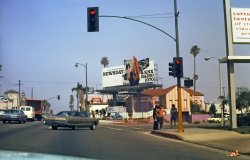
- Doesn't Cotton: 1936
- ... money (for needles, thread, and even light to mend at night), time, and energy to mend clothes.
In this photo, speaking as a ... Posted by Dave - 09/16/2013 - 10:45am -
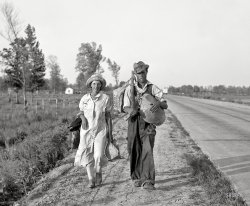
- Cathedral Place: 1906
- ... is one of the most pleasant cities to walk around in at night. That probably sounds crazy, but it's FACT.
As a kid growing up in ... Posted by Dave - 01/28/2020 - 1:55pm -
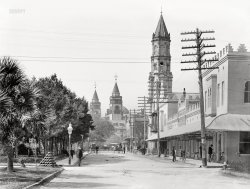
- Modern Family: 1941
- ... to doing without electric items but they needed light at night. It was also difficult to rewire an existing house. In this case I ... Posted by Dave - 01/31/2019 - 10:40am -
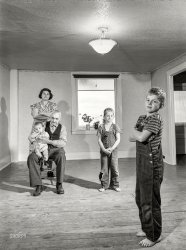
- A Star Is Born: 1954
- ... in the Navy and stationed near San Diego I was taking a night class at San Diego State; one evening we heard that Judy was rehearsing ... Posted by Dave - 05/15/2013 - 12:14pm -
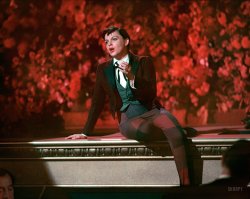
- Margaret: 1925
- Next up in the Shorpy Sunday Night Cavalcade of Enigmatic Portraits Dated Dec. 12, 1925: "Miss Margaret Van ... Posted by Dave - 09/04/2012 - 3:59pm -
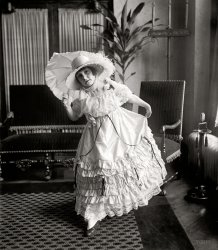
- Capitol Chill: 1940
- ... "Washington snow scenes. U.S. Capitol, East Front, at night in winter." 8x10 inch safety negative by Theodor Horydczak. View full ... Posted by Dave - 12/20/2014 - 10:30am -
![Capitol Chill: 1940 Circa 1940. "Washington snow scenes. U.S. Capitol, East Front, at night in winter." 8x10 inch safety negative by Theodor Horydczak. View full size.
Structural note concerning the domeFew people realize the revolutionary nature of this majestic dome. Though inspired in European models, the structure of the double dome is made of (at the time) a revolutionary cast iron frame and skin. Begun in 1855 (replacing the dome previously built by Charles Bulfinch), the structure was designed by Thomas U. Walter. By the end of 1863 Walter was able to set the Statue of Freedom atop the dome but it was not until 1866 that Constantino Brumidi unveiled his fresco of the Apotheosis of Washington, painted around dome's oculus, signaling the conclusion of the work.
Interesting patternThe black sky has a pattern that I've only seen when you litho screen some patterns that I know as Mackey lines. Does anyone know what caused this? Oil adhesion on a drum scanner.
[Newton rings, and there is no drum scanner. -Dave]
Wanna see those particular columns?Don't head for the Capitol, try the National Arboretum.
Capitol scaffoldingThe Capitol dome is now encased in scaffolding, as a two year project to repair all the leaks and refurbish the dome has begun.
(The Gallery, D.C., Theodor Horydczak)](https://www.shorpy.com/files/images/SHORPY-5a37608u.thumbnail.jpg)
- Princess Fatima: 1921
- ... learned, takes out her nose jewel when she goes to bed at night, as other women remove their earrings. Unlike American women, she is not ... Posted by Dave - 09/27/2017 - 9:47am -
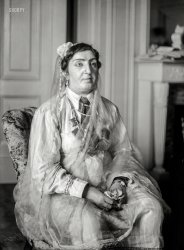
- Men of Steel: 1938
- ... their lives by merely entering the city limits.
On the night of May 12, 1937, 25,000 workers went on strike at Jones and Laughlin. It ... Posted by Dave - 09/09/2011 - 12:06pm -
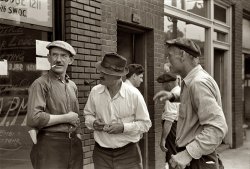
- Artillery Hall Ball: 1910
- ... by the Glad-U-Kum and Merry Widow social clubs on Shriners Night. View full size.
Ford, Bacon & Davis Streetcar Before the ... Posted by Dave - 01/15/2018 - 11:37pm -
![Artillery Hall Ball: 1910 April 1910. "Washington Artillery Hall, St. Charles Avenue, New Orleans." With signs advertising a "Fancy Dress and Masquerade Ball" given by the Glad-U-Kum and Merry Widow social clubs on Shriners Night. View full size.
Ford, Bacon & Davis StreetcarBefore the more well-known green Perley streetcars, the St. Charles line used Ford, Bacon & Davis cars, built in the 1890s.
Here's of the one remaining FB&D cars, next to a traditional Perley of the 1920s. Also a great article, explaining the history.
https://gonola.com/things-to-do-in-new-orleans/history/nola-history-the-...
The Final SalvoWashington Artillery as a Buick dealership, with the regiment long gone, before final demolition in 1952
Glad-U-KumIn 2012, Shorpy showed us the Cathedral housing the
Washington ArtilleryOne of the oldest National Guard units in the United States, the Washington Artillery [by that name] traces its origins back to 1819, although it may have descended from an earlier military unit in New Orleans.
The unit first saw combat during the Mexican War. The 1st through 4th Companies saw combat in every major campaign of the Confederate Army of Northern Virginia, and the 5th Company saw combat in every major campaign in the Western theatre, from Shiloh to the final battles in Alabama.
The unit was mobilized during the war with Spain in 1898 but saw no action. It served on the Mexican Border in 1916-1917 in support of Pershing's Punitive Expedition, and saw action in France during WW1 [by this time it was officially known as the 141st Field Artillery Regiment].
It saw combat action in the Italian campaign during WW2, and continues as an active unit of the Louisiana National Guard to this day.
(The Gallery, DPC, New Orleans)](https://www.shorpy.com/files/images/SHORPY-4a23674a.thumbnail.jpg)
- The Farmer's Son: 1941
- ... View full size.
Grooming Combed his hair all night with a pillowcase.
His eyes Beautiful. Hope he had blue eyes.
... Posted by Dave - 11/03/2019 - 8:12pm -
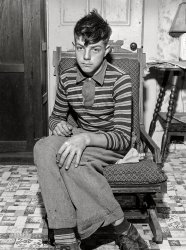
- How to Make a Hairbrush: 1912
- ... for the boys than doin' nothin'.' The mother said the night work hurts their eyes and John said so too. He was not very enthusiastic ... Posted by Dave - 09/09/2011 - 11:15am -
![How to Make a Hairbrush: 1912 6 p.m., January 31, 1912. "Making hair-brushes. Hausner family, 310 East 71st Street, New York. Frank is 6 years old and John is 12. The mother had a sore throat and wore a great rag wrapped around it, but she took it off for the photo. They said they all (including the 6 yr old) worked until 10 p.m. when busy. Their neighbor corroborated this. She said, 'It's a whole lot better for the boys than doin' nothin'.' The mother said the night work hurts their eyes and John said so too. He was not very enthusiastic about the beauties of work. All together, they make about $2 a week. Father is a motorman." Photo and caption by Lewis Wickes Hine. View full size.
Tedious!That looks very tedious. And what is the light source? Seems like they would need good light to even see what they are doing with those tiny bristles.
[Which were probably pig bristles. - Dave]
(The Gallery, Kids, Lewis Hine, NYC)](https://www.shorpy.com/files/images/05488u.thumbnail.jpg)
- Die Meistersingerin: 1917
- ... Hempel appeared at the Metropolitan Opera House last night in the role of Eva in "Die Meistersinger" for the first time here, and ... Posted by Dave - 03/24/2017 - 10:32pm -

- Park Terminal: 1943
- ... "Baltimore, Maryland. Trolleys inside the Park Terminal at night." Photo by Marjory Collins for the Office of War Information. View full ... Posted by Dave - 11/01/2013 - 8:47am -
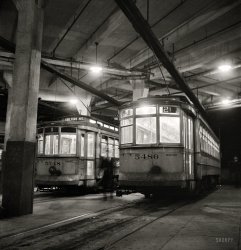
- Carrying-In Boy: 1908
- ... for several years. Works nine hours. Day shift one week, night shift next week. Gets $1.25 per day." Photograph and caption by Lewis ... Posted by Dave - 08/15/2012 - 9:35am -
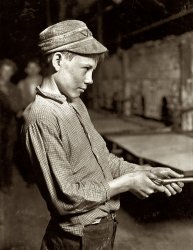
- Powder Roomer: 1940
- ...
A bright idea Some years ago, I spent a night in New Orleans at the Kentucky Hotel (or maybe the Hotel Kentucky) in a ... Posted by Dave - 09/02/2020 - 1:53pm -
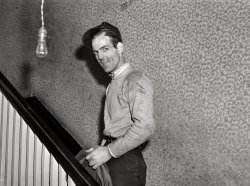
- Cumberland Glass Works: 1909
- November 1909. Blowing bottles. Night shift at the Cumberland Glass Works in Bridgeton, New Jersey. View full ... Posted by Dave - 12/10/2007 - 3:21pm -
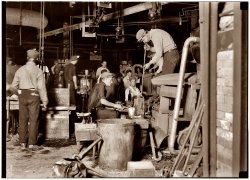
- Let's Roll: 1926
- ... not scheduled to use the Arcade until tomorrow night, a roller hockey game has been booked for tonight at 9:30 o'clock, when ... Posted by Dave - 09/22/2012 - 12:09am -
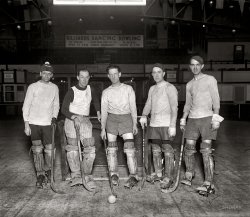
- Rural Customs: 1942
- ... herd my 6'3", 225-lb. roommate around the ballroom. The night before "auditions," those of us who could hoof it a little attempted to ... Posted by Dave - 12/03/2013 - 4:45pm -
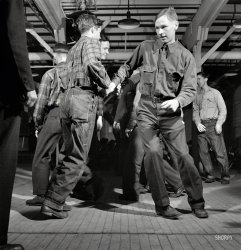
- Fly BOAC: c.1958
- ... an incredible chick magnet. Co-eds loved to ride in it at night with the windows down, and my buddies and I loved to oblige them. BTW, ... Posted by Rute Boye - 07/13/2012 - 10:37pm -
![Fly BOAC: c.1958 This is one of many color slides that my father shot when we lived in the San Francisco area in the mid to late 1950's. This particular shot was taken on Anscochrome film and shows Union Square in downtown SF. Note the overhead wires for the electric buses. I have many more like this, which I'll try to post as time allows. View full size.
A Corvette!Gimme that Vette, please!
Time LineThat 1958 Chevrolet looks like the newest car in the pic. This would make the earliest date fall of 1957. I don't remember that chrome piece at the rear of the back window.
[That bit of chrome was specific to certain Bel Air models. - tterrace]
A rare body styleThe Corvette is cool, but I'll take the '58 Bel-air hardtop. In fact, I had one almost exactly like it, bought it used in 1962 to go to college in. 1958 was a rare year for the entire GM lineup. The cars were new from the 55-57 group, but strangely not repeated in 59. The 58 models had another distinction––there were more available body styles than in 57 and previous years, or 59 and succeeding years. The one pictured here was a rare variation of the Bel-air 4-door hardtop. Most Bel-air 4-door hardtops had a slightly different treatment of the roofline and rear door pillars. This one is white over silver blue. Mine was silver blue over white, otherwise this car would be identical to mine. The car was a dreamboat and proved at college to be an incredible chick magnet. Co-eds loved to ride in it at night with the windows down, and my buddies and I loved to oblige them. BTW, the "V" emblem on the hood indicates a V8 engine, the soon to be famous "small block" Chevy. First year with 283 cubes, too. What a car!
B O A CAs our Brit friends explain it, "Better On A Camel"!
Thanks to DbellI sing with a community chorus, and we just wrapped up a concert series that was all music from the Beatles. Thanks to Dbell's pointing out the B.O.A.C. sign, I now have "Back in the U.S.S.R." stuck in my head - "Flew in from Miami Beach B.O.A.C...." Thanks for a great historic picture of one of my favorite cities!
(ShorpyBlog, Member Gallery)](https://www.shorpy.com/files/images/Union_Square_1.thumbnail.jpg)
- Happy Anniversary
- ... endlessly complained about my grandmother's cooking. One night he heard noises in the kitchen and found his mother tucking into the food ... Posted by Mudhooks - 10/10/2010 - 5:20pm -

- Municipal Gothic: 1908
- ... Built in 1872, it stood till 1921 when it burned on the night of Jan. 12. The Ohio Theater (built in 1928) now sits on this site.
... Posted by Dave - 10/14/2013 - 9:23am -
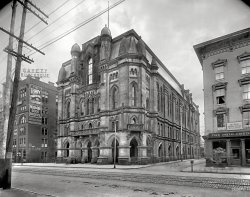
- Schlitz Hotel: 1910
- ... bet they were gorgeous when backlit in the late evening or night. Also the turret corner is lovely. The Bank is my favorite with all the ... Posted by Dave - 10/14/2016 - 9:47pm -
![Schlitz Hotel: 1910 Circa 1910. "Schlitz Hotel, Atlantic City." On the Boardwalk at Ocean Avenue. 8x10 inch dry plate glass negative, Detroit Publishing Company. View full size.
Beer Hotels?I see that the Schlitz Hotel has the same logo as the brewery and next door (to our left) is the Blatz Hotel. That was (is?) another brewery from back in the day. Did these breweries own lodgings? I know that they did run restaurants that showcased their products. Also, these hotels were in Atlantic City, a long way from Milwaukee, and that beer didn't travel that well in those days, was there a locally-owned brewery?
[The sign next door is for Blatt Royal, a haberdashery. - tterrace]
Lovely Stained GlassSuch interesting buildings. I love the designs and visual interest each have. The details, such as the stained glass awning at the Schlitz entrance and the transom on the other hotel. I bet they were gorgeous when backlit in the late evening or night. Also the turret corner is lovely. The Bank is my favorite with all the beautiful ironwork. Too bad we don't have such interesting and pretty details on buildings today. Instead most of what we have today is a square, bland Lego block style. IMHO they are depressing to look at.
(The Gallery, Atlantic City, DPC)](https://www.shorpy.com/files/images/SHORPY-4a24009a.thumbnail.jpg)
- Mrs. Henry Dukes: 1941
- ... been able to shake this image since first seeing it last night. This gaunt woman, relatively young, with “about” nine children, and ... Posted by Dave - 11/05/2019 - 7:30pm -
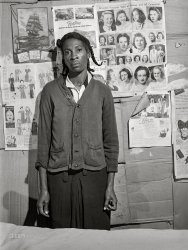
- It's a Small(er) World: 1969
- ... Disneyland was a great and relatively inexpensive date night back then. Grad Night was filled with high school graduates and dates for a few dollars and my ... Posted by rsyung - 09/15/2017 - 7:25pm -
























